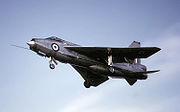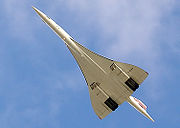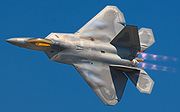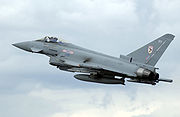
Supercruise
Encyclopedia

Supersonic
Supersonic speed is a rate of travel of an object that exceeds the speed of sound . For objects traveling in dry air of a temperature of 20 °C this speed is approximately 343 m/s, 1,125 ft/s, 768 mph or 1,235 km/h. Speeds greater than five times the speed of sound are often...
flight of an aircraft
Aircraft
An aircraft is a vehicle that is able to fly by gaining support from the air, or, in general, the atmosphere of a planet. An aircraft counters the force of gravity by using either static lift or by using the dynamic lift of an airfoil, or in a few cases the downward thrust from jet engines.Although...
with a useful cargo, passenger, or weapons load performed efficiently and without the use of afterburner
AfterBurner
The AfterBurner is a lighting solution for the Game Boy Advance system that was created by Triton-Labs.Originally, portablemonopoly.net was a website created to petition Nintendo to put some kind of light in their Game Boy Advance system...
s ("reheat").
Due to its combination of decades long scheduled service and length of time spent at supersonic speeds, the main user of supercruise was Concorde
Concorde
Aérospatiale-BAC Concorde was a turbojet-powered supersonic passenger airliner, a supersonic transport . It was a product of an Anglo-French government treaty, combining the manufacturing efforts of Aérospatiale and the British Aircraft Corporation...
, with more time spent in supersonic, largely supercruise, flight than all of the other aircraft put together.
Advantages
Most military aircraft use afterburnerAfterBurner
The AfterBurner is a lighting solution for the Game Boy Advance system that was created by Triton-Labs.Originally, portablemonopoly.net was a website created to petition Nintendo to put some kind of light in their Game Boy Advance system...
s (or reheat) to travel at supersonic speeds. Afterburners are inefficient compared to conventional jet engine operation due to the low pressures typically found in the exhaust section. Therefore an aircraft that can supercruise has generally greater endurance at supersonic speeds than one which cannot. Furthermore, without a requirement to carry such a large quantity of fuel, a supercruise-capable aircraft can have a more favorable fuel fraction
Fuel fraction
In aerospace engineering, an aircraft's fuel fraction, fuel weight fraction, or a spacecraft's propellant fraction, is the weight of the fuel or propellant divided by the gross take-off weight of the craft :...
, the proportion of the plane's overall mass which is devoted to fuel. Supercruise is also an advantage for stealth
Stealth technology
Stealth technology also termed LO technology is a sub-discipline of military tactics and passive electronic countermeasures, which cover a range of techniques used with personnel, aircraft, ships, submarines, and missiles, to make them less visible to radar, infrared, sonar and other detection...
aircraft, as an afterburner plume both reflects radar signals and creates a significant infrared signature.
History

English Electric Lightning
The English Electric Lightning is a supersonic jet fighter aircraft of the Cold War era, noted for its great speed and unpainted natural metal exterior finish. It is the only all-British Mach 2 fighter aircraft. The aircraft was renowned for its capabilities as an interceptor; Royal Air Force ...
, on August 11, 1954. However, this early demonstration of supercruise was extremely limited; the Lightning could supercruise at approximately Mach 1.22 while later versions were able to achieve much higher speeds.
The British Aircraft Corporation Tactical Strike/Reconnaissance 2 (TSR-2)
BAC TSR-2
The British Aircraft Corporation TSR-2 was a cancelled Cold War strike and reconnaissance aircraft developed by the British Aircraft Corporation for the Royal Air Force in the late 1950s and early 1960s...
, which first flew on September 27, 1964, was one of the first military aircraft specifically designed to cruise supersonically; one of the planned mission profiles was for a supersonic cruise at Mach 2.00 at 50–58,000 ft. The TSR-2 used Bristol Olympus
Rolls-Royce Olympus
The Rolls-Royce Olympus was one of the world's first two-spool axial-flow turbojet aircraft engines, originally developed and produced by Bristol Aero Engines. First running in 1950, its initial use was as the powerplant of the Avro Vulcan V Bomber...
engines, a later version of which would also power Concorde
Concorde
Aérospatiale-BAC Concorde was a turbojet-powered supersonic passenger airliner, a supersonic transport . It was a product of an Anglo-French government treaty, combining the manufacturing efforts of Aérospatiale and the British Aircraft Corporation...
.
Many of the fighters listed as capable of supercruise can only marginally exceed the speed of sound
Speed of sound
The speed of sound is the distance travelled during a unit of time by a sound wave propagating through an elastic medium. In dry air at , the speed of sound is . This is , or about one kilometer in three seconds or approximately one mile in five seconds....
without afterburners and may only be able to do so without an external weapons load.
In day-to-day operation the Tupolev Tu-144
Tupolev Tu-144
The Tupolev Tu-144 was a Soviet supersonic transport aircraft and remains one of only two SSTs to enter commercial service, the other being the Concorde...
and Concorde both used afterburners to accelerate quickly through the high-drag
Drag (physics)
In fluid dynamics, drag refers to forces which act on a solid object in the direction of the relative fluid flow velocity...
transonic
Transonic
Transonic speed is an aeronautics term referring to the condition of flight in which a range of velocities of airflow exist surrounding and flowing past an air vehicle or an airfoil that are concurrently below, at, and above the speed of sound in the range of Mach 0.8 to 1.2, i.e. 600–900 mph...
flight regime before deactivating them to supercruise. Doing this minimized fuel use, even though afterburners are relatively inefficient. Both aircraft were capable of achieving supersonic flight without the use of afterburners; however, doing so meant that they spent much longer in the high-drag transonic flight envelope, and this made the short use of afterburners more fuel efficient over the whole flight.
Military use
The term supercruise was originally used to describe a fighter performance requirement set forth by USAF Col. John BoydJohn Boyd (military strategist)
Colonel John Boyd was a United States Air Force fighter pilot and Pentagon consultant of the late 20th century, whose theories have been highly influential in the military, sports, and business.-Biography:...
, Pierre Sprey, and Col. Everest Riccioni, proponents of the F-16 Falcon. Following the entry into production of the F-16, they began work on an improved fighter design with the ability to cruise supersonically over enemy territory for a minimum of twenty minutes. As air combat is often the result of surprise, and the speed of the combat is determined by the speed of the surprising aircraft, this would have given a supercruise-capable design a worthwhile performance advantage in many situations. The postulated fighter would have had a top speed of just over Mach 1, and a fuel fraction in excess of 40%, the minimum required to successfully meet the twenty-minute requirement. Meeting the fuel fraction requirement necessitated a very austere design with few advanced electronics. The United States Air Force showed no interest in the proposal at that time, but years later revived the term and redefined it to apply to the requirements for the Advanced Tactical Fighter
Advanced Tactical Fighter
The Advanced Tactical Fighter was a demonstration and validation program undertaken by the United States Air Force to develop a next-generation air superiority fighter to counter emerging worldwide threats, including Soviet Sukhoi Su-27 and Mikoyan MiG-29 fighters under development in the 1980s...
, which resulted in the F-22 Raptor.


F-22 Raptor
The Lockheed Martin/Boeing F-22 Raptor is a single-seat, twin-engine fifth-generation supermaneuverable fighter aircraft that uses stealth technology. It was designed primarily as an air superiority fighter, but has additional capabilities that include ground attack, electronic warfare, and signals...
's supercruise capabilities are touted as a major performance advantage over other fighters. Even so, supercruising uses much more fuel to travel the same distance than at subsonic speeds: The Air Force Association estimates that use of supercruise for a 100 nautical miles (185.2 km) dash as part of a mission would cut the F-22's combat radius from about 600 nautical miles (1,111.2 km) to about 450 nautical miles (833.4 km). However, this is still unconfirmed as the altitude and flight profile are classified (as are most of the F-22's capabilities).
The F-22 has demonstrated supercruise speeds of at least Mach 1.7, a difference of 320 knots (627 km/h) indicated airspeed (KIAS) at 40000 ft (12,192 m). Supercruise in militarily significant parlance is meant to imply a significant increase in effective combat speed with a full weapons load over existing types. Virtually all current and past jet fighters, prior to the F-22, cruise at approximately Mach 0.8–0.9 with a militarily significant weapons load. The F-22 represents a significant advance in cruise speed over previous types.
The key challenge in attaining supercruise is not simply attaining a high static thrust to weight ratio. Engine thrust and efficiency can vary greatly with speed and altitude. In order to achieve significant dry thrust at high supersonic speed, the engine (and airframe) must be built purposely with this goal in mind. Conversely, there is nothing special about being able to marginally exceed the speed of sound with a "regular" jet engine, as any supersonic engine is capable of surviving supercruise conditions, even if they may not provide enough dry power to maintain supersonic flight.
There are a few engines in production that are designed to facilitate tactically significant supercruise.
- The Pratt & Whitney F119Pratt & Whitney F119|-See also:-External links:* *...
in combination with the F-22 Raptor - The Snecma M88SNECMA M88|-See also:-External links:* * Snecma M88's pdf* *...
engine in the Dassault RafaleDassault RafaleThe Dassault Rafale is a French twin-engine delta-wing multi-role jet fighter aircraft designed and built by Dassault Aviation. Introduced in 2000, the Rafale is being produced both for land-based use with the French Air Force and for carrier-based operations with the French Navy...
allows it to supercruise in dry power, even with four missiles and a 1000-liter belly tank and even in the naval version; it can supercruise up to Mach 1.4 while carrying six air-to-air missileAir-to-air missileAn air-to-air missile is a missile fired from an aircraft for the purpose of destroying another aircraft. AAMs are typically powered by one or more rocket motors, usually solid fuelled but sometimes liquid fuelled...
s (MBDA MICAMBDA MICAThe MBDA MICA is an anti-air multi-target, all weather, fire-and-forget short and medium-range missile system. It is intended for use both by air platforms as individual missiles as well as ground units and ships, which can be equipped with the rapid fire MICA Vertical Launch System...
). - The EJ200Eurojet EJ200|-See also:-External links:* * * * *...
engine built by EuroJet Turbo GmbHEuroJet Turbo GmbHEuroJet Turbo GmbH is a multi-national consortium, the partner companies of which are Rolls-Royce plc, Avio of Italy, ITP of Spain and MTU Aero Engines of Germany. It is based in Hallbergmoos near Munich....
adds the supercruise capability in the Eurofighter TyphoonEurofighter TyphoonThe Eurofighter Typhoon is a twin-engine, canard-delta wing, multirole combat aircraft, designed and built by a consortium of three companies: EADS, Alenia Aeronautica and BAE Systems; working through a holding company, Eurofighter GmbH, which was formed in 1986...
, and is capable of supercruising at Mach 1.5. Typhoon pilots have stated that Mach 1.3 is attainable in combat configuration with external stores. - The General Electric F414G in JAS 39 Gripen NGJAS 39 GripenThe Saab JAS 39 Gripen is a lightweight single-engine multirole fighter manufactured by the Swedish aerospace company Saab. It was designed to replace the Saab 35 Draken and 37 Viggen in the Swedish Air Force...
is designed for supercruise and has been shown to achieve Mach 1.2.
The Pratt & Whitney F135
Pratt & Whitney F135
The Pratt & Whitney F135 is an afterburning turbofan developed for the F-35 Lightning II single-engine strike fighter. The F135 family has several distinct variants, including a conventional, forward thrust variant and a multi-cycle STOVL variant that includes a forward lift fan...
and the General Electric/Rolls-Royce F136
General Electric/Rolls-Royce F136
The General Electric/Rolls-Royce F136 is an advanced turbofan engine being developed by General Electric and Rolls-Royce plc for the Lockheed Martin F-35 Lightning II.-Development:...
interchangeable engines for the Joint Strike Fighter each have a higher power output than the F119 they were derived from, and could in theory facilitate supercruise. However, the engines were not designed to supercruise in the F-35.
NPO Saturn
NPO Saturn
NPO Saturn is a Russian aircraft engine manufacturer, formed from the mergers of Rybinsk and Lyul'ka-Saturn . Saturn's engines power many former Eastern Bloc aircraft, such as the Tupolev Tu-154. Saturn holds a 50% stake in the PowerJet joint venture with Snecma...
is developing a supercruise-capable derivative of its AL-41 engine for the Sukhoi PAK FA
Sukhoi PAK FA
The Sukhoi PAK FA is a twin-engine jet fighter being developed by Sukhoi OKB for the Russian Air Force. The Sukhoi T-50 is the prototype for PAK FA. The PAK FA is one of only a handful of stealth jet programs globally...
and the Indo-Russian Sukhoi/HAL FGFA
Sukhoi/HAL FGFA
The Sukhoi/HAL Fifth Generation Fighter Aircraft is a fifth-generation fighter being developed by Russia and India. It is a derivative project from the PAK FA being developed for the Indian Air Force .Two separate prototypes will be developed, one by Russia and a separate one by India...
. This is yet to bear fruit, but the stop-gap AL-31 117S engine, produced by this program, seems to achieve the supercruise goal already. It was recently announced that during testing of a Su-35BM fighter equipped with these engines it was traveling in the ~M1.1–1.2 airspeed range at nominal power and was still accelerating, thus suggesting that the supercruise was possible at even higher speed. Further testing will show the extent of this possibility.
All known supercruise aircraft can only do so at considerable altitude (where the air is thinner and so offers less resistance), which restricts the use of terrain mask
Terrain mask
Terrain mask is a term used in both aviation and GPS equipment.A terrain mask refers to the natural curvature of the earth. It is important as a means of avoiding active radar by positioning the aircraft so there is natural earth hiding it from the radio waves sent from the radar system...
and so makes any non-stealth aircraft very obvious.
Aircraft designed to cruise on afterburner
The Pratt & Whitney J58Pratt & Whitney J58
The Pratt & Whitney J58 was a jet engine used on the Lockheed A-12, and subsequently on the YF-12 and SR-71 Blackbird aircraft. The J58 was a variable cycle engine which functioned as both a turbojet and a fan-assisted ramjet. The J58 was a single-spool turbojet engine with an afterburner...
engines of the Lockheed A-12 and SR-71 Blackbird
SR-71 Blackbird
The Lockheed SR-71 "Blackbird" was an advanced, long-range, Mach 3+ strategic reconnaissance aircraft. It was developed as a black project from the Lockheed A-12 reconnaissance aircraft in the 1960s by the Lockheed Skunk Works. Clarence "Kelly" Johnson was responsible for many of the...
were designed for sustained and efficient operation at supersonic speeds using afterburners with air that was diverted past the turbojet core of the engine. This gave a good compression ratio and higher efficiency simply due to the ram effect at the high operating speed of the aircraft. The afterburners acted essentially as ramjet
Ramjet
A ramjet, sometimes referred to as a stovepipe jet, or an athodyd, is a form of airbreathing jet engine using the engine's forward motion to compress incoming air, without a rotary compressor. Ramjets cannot produce thrust at zero airspeed and thus cannot move an aircraft from a standstill...
s and these types of engines achieve peak efficiency at around Mach 3.
In a somewhat similar vein, the XB-70A Valkyrie made use of specially designed turbojets (six General Electric YJ-93
General Electric YJ93
-See also:-External links:...
engines) to sustain speeds in excess of Mach 3. Unlike the J58 engines powering the SR-71, the YJ-93 engines of the XB-70A did not require the use of special fuel, and did not radically modify the intake/exhaust geometry in order to achieve Mach 3 flight. The YJ-93 engines did operate in afterburner at Mach 3; however, the engines were specifically designed to be very efficient in afterburner, and the XB-70A AV-2 prototype sustained speeds in excess of Mach 3 for 32 minutes on one flight. Furthermore, the type was designed to operate at such speeds for periods of hours over intercontinental ranges.
Ramjets and scramjets
RamjetRamjet
A ramjet, sometimes referred to as a stovepipe jet, or an athodyd, is a form of airbreathing jet engine using the engine's forward motion to compress incoming air, without a rotary compressor. Ramjets cannot produce thrust at zero airspeed and thus cannot move an aircraft from a standstill...
and scramjet
Scramjet
A scramjet is a variant of a ramjet airbreathing jet engine in which combustion takes place in supersonic airflow...
powered aircraft have to date been mostly experimental (with exceptions such as the SR-71 and its turbojet/ramjet hybrid J58
Pratt & Whitney J58
The Pratt & Whitney J58 was a jet engine used on the Lockheed A-12, and subsequently on the YF-12 and SR-71 Blackbird aircraft. The J58 was a variable cycle engine which functioned as both a turbojet and a fan-assisted ramjet. The J58 was a single-spool turbojet engine with an afterburner...
engines, as noted above; and there have been numerous ramjet missiles), but these engines operate most efficiently at supersonic speeds and therefore would be theoretically ideal for an aircraft intended to spend long periods in supersonic flight. Due to the exotic nature of the engines, whether this would be considered "supercruise" is largely semantic.
Aircraft with supercruise
Aircraft with supercruise include:- English Electric LightningEnglish Electric LightningThe English Electric Lightning is a supersonic jet fighter aircraft of the Cold War era, noted for its great speed and unpainted natural metal exterior finish. It is the only all-British Mach 2 fighter aircraft. The aircraft was renowned for its capabilities as an interceptor; Royal Air Force ...
(The first aircraft capable of supercruise) - LockheedLockheed CorporationThe Lockheed Corporation was an American aerospace company. Lockheed was founded in 1912 and later merged with Martin Marietta to form Lockheed Martin in 1995.-Origins:...
Blackbird (A-12, YF-12 and SR-71) - Tupolev Tu-128
- Tupolev Tu-144Tupolev Tu-144The Tupolev Tu-144 was a Soviet supersonic transport aircraft and remains one of only two SSTs to enter commercial service, the other being the Concorde...
- ConcordeConcordeAérospatiale-BAC Concorde was a turbojet-powered supersonic passenger airliner, a supersonic transport . It was a product of an Anglo-French government treaty, combining the manufacturing efforts of Aérospatiale and the British Aircraft Corporation...
- BAC TSR-2BAC TSR-2The British Aircraft Corporation TSR-2 was a cancelled Cold War strike and reconnaissance aircraft developed by the British Aircraft Corporation for the Royal Air Force in the late 1950s and early 1960s...
- F-16XLF-16XLThe General Dynamics F-16XL is a derivative of the F-16 Fighting Falcon, with a cranked-arrow delta wing. It was entered in the United States Air Force's Enhanced Tactical Fighter competition but lost to the F-15E Strike Eagle...
- Eurofighter TyphoonEurofighter TyphoonThe Eurofighter Typhoon is a twin-engine, canard-delta wing, multirole combat aircraft, designed and built by a consortium of three companies: EADS, Alenia Aeronautica and BAE Systems; working through a holding company, Eurofighter GmbH, which was formed in 1986...
- Dassault RafaleDassault RafaleThe Dassault Rafale is a French twin-engine delta-wing multi-role jet fighter aircraft designed and built by Dassault Aviation. Introduced in 2000, the Rafale is being produced both for land-based use with the French Air Force and for carrier-based operations with the French Navy...
- Gripen NGJAS 39 GripenThe Saab JAS 39 Gripen is a lightweight single-engine multirole fighter manufactured by the Swedish aerospace company Saab. It was designed to replace the Saab 35 Draken and 37 Viggen in the Swedish Air Force...
- F-22 RaptorF-22 RaptorThe Lockheed Martin/Boeing F-22 Raptor is a single-seat, twin-engine fifth-generation supermaneuverable fighter aircraft that uses stealth technology. It was designed primarily as an air superiority fighter, but has additional capabilities that include ground attack, electronic warfare, and signals...
- YF-23 Black Widow IIYF-23 Black Widow IIThe Northrop YF-23 or Northrop–McDonnell Douglas YF-23 was an American single-seat, twin-engine fighter aircraft designed for the United States Air Force . The design was a finalist in the USAF's Advanced Tactical Fighter competition, battling the Lockheed YF-22 for a production contract...
- Sukhoi Su-35BM
Projected aircraft:
- Zero Emission Hyper Sonic TransportZero Emission Hyper Sonic TransportThe Zero Emission Hyper Sonic Transport or ZEHST is a supersonic passenger airliner project by EADS and Japan. It can be seen as a descendent of the Concorde airliner....
- SonicStar

